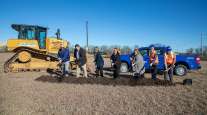Staff Reporter
Cashless Tolling Is Coming to Kansas Turnpike in 2024

[Stay on top of transportation news: Get TTNews in your inbox.]
Making driving safer between the Oklahoma border and Kansas City is among the benefits of a massive Kansas Turnpike Authority project to update its 1950s tolling system by replacing 21 toll plazas with overhead gantry cameras and transponder sensors.
“Cashless tolling will be safer, more convenient and more efficient for all drivers on the Kansas Turnpike,” said Steve Hewitt, KTA CEO. “With more than 65% of customers using a K-TAG or compatible tolling device, an aging workforce and a cash toll system in need of replacement, the time is right to transition to cashless tolling.”
The cashless system will enable free-flow traffic between the KTA and connecting roadways. Drivers will no longer have to slow or stop near toll plazas once the existing 21 toll plazas are demolished and reconfigured (within 18 to 24 months).
One of the reasons KTA decided to convert to cashless tolling was its aging cash collection equipment. Rather than spend money on a direct replacement, KTA decided to invest in a cashless system for improved operational efficiency, better safety and greater customer ease. Cost savings was not the primary motivation to move to cashless conversion, expected by mid-2024.
Some drivers now find the KTA’s entry/exit system (created in the 1950s when it opened) complex. Thus, KTA officials have devised an easier system that will be rolled out by moving its tolling points onto the roadway itself. Overhead gantries will be installed that identify a driver’s license plate and or K-TAG or similar compatible transponder windshield devices.
Customers will be billed based on how many gantries they pass under. No rates have been established for truckers or drivers of other vehicles. The KTA board has not yet approved specific toll rates per mile for cashless tolling, but there will be two toll rates: one for transponder devices and another for images taken by gantry cameras of license plates.
“Customers using a K-TAG or a compatible tolling device will continue to pay the lowest toll on the Kansas Turnpike,” said Hewitt.
The KTA board is reviewing toll rate information with plans to determine cashless toll rates in October, noted Rachel Bell, KTA director of business services and customer relations.

In the last few years, KTA has made improvements that benefit truckers, such as increasing vertical clearance on 69 overhead bridges. (Kansas Turnpike Authority)
The 236-mile turnpike does not receive any state or federal funds despite being part of the interstate system. Instead it relies on toll revenue to fund its preservation and modernization.
“Converting our 65-plus-year legacy system to cashless tolling is a complex investment of approximately $85 million, but one that was necessary due to aging equipment and our goal to modernize,” said Bruce Meisch, KTA’s technology director, who is managing the cashless tolling project. “Our entire system is changing from the roadway with new toll zones and equipment to an entirely new back-office system including customer-facing tools.”
Truck traffic is increasing annually on the turnpike. In fiscal year 2023 (from July 1, 2022, to June 30, 2023), 4.36 million commercial vehicles traveled on the KTA, up nearly 5% from the previous fiscal year. Some 4.13 million commercial vehicles traveled along KTA in fiscal year 2021.
“KTA is making considerable enhancements to our system with truckers in mind,” said David Jacobson, engineering director. “Cashless tolling will eliminate the need for drivers to stop, which saves time and money, especially for commercial traffic. Over time toll plazas will be removed, easing congestion and improving traffic flow.”

A truck service parking area. (Kansas Turnpike Authority)
In the last few years, KTA has made improvements that benefit truckers, such as increasing vertical clearance on 69 overhead bridges, adding 150 new truck parking stalls at three service areas and lengthening acceleration/deceleration lanes at service areas and some interchanges.
When cashless tolling begins in mid-2024, truckers will benefit from additional enhancements: wrong-way detection notifications, signage showing available truck parking spaces at service areas and an account management system that better accommodates fleets.
Want more news? Listen to today's daily briefing below or go here for more info:




